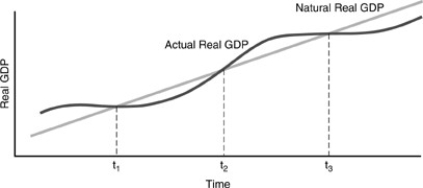A) inflation.
B) the interest rate.
C) employment.
D) productivity.
Correct Answer

verified
Correct Answer
verified
Multiple Choice
At a business cycle peak,we usually have ________ real Gross Domestic Product.
A) an all-time high level of
B) an all-time low level of
C) an historically average level of
D) accelerating growth of
E) the maximum growth rate of
Correct Answer

verified
Correct Answer
verified
Multiple Choice
Our business cycle experiences suggest that a macroeconomic policy designed to lower the average rate of inflation will require ________ in actual real GDP and an accompanying ________ in the unemployment rate.
A) an increase,increase
B) an increase,decrease
C) a reduction,increase
D) a reduction,decrease
Correct Answer

verified
Correct Answer
verified
Multiple Choice
Between 1900 and 2007,the ratio of actual to natural real GDP hit its low point in
A) 1933.
B) 1904.
C) 1944.
D) 1982.
Correct Answer

verified
Correct Answer
verified
Multiple Choice
The "Big Three" concepts of Macroeconomics are
A) profits,liquidity,and sustainability.
B) unemployment rate,inflation,and economic growth.
C) asset rebalancing,markups,and profitability.
D) federal budget,foreign trade,and quantitative easing.
Correct Answer

verified
B
Correct Answer
verified
Multiple Choice
A low unemployment rate implies that
A) job offers are scarce and inflation is high.
B) job offers are plentiful and wages are high.
C) jobs are permanent and job offers are plentiful.
D) jobs are difficult to find,and wages are low.
Correct Answer

verified
B
Correct Answer
verified
Multiple Choice
Economy with no productivity growth is called the
A) zero-sum society.
B) zero-growth society.
C) export-led society.
D) doomed-to-fail society.
Correct Answer

verified
Correct Answer
verified
Multiple Choice
Figure 1-2
 -When the actual real GDP exceeds the natural real GDP as in Figure 1-2 above,we expect to find that unemployment is
-When the actual real GDP exceeds the natural real GDP as in Figure 1-2 above,we expect to find that unemployment is
A) high and inflation is high.
B) low and inflation is high.
C) low and inflation is low.
D) high and inflation is low.
Correct Answer

verified
Correct Answer
verified
Multiple Choice
A rising inflation rate tends to help the following types of people:
A) retirees and students with savings accounts.
B) borrowers and homeowners without mortgages.
C) homeowners with mortgages and students with loans.
D) landowners and borrowers.
Correct Answer

verified
Correct Answer
verified
Multiple Choice
Prior to 1995 productivity growth in Europe was ________ in the United States.
A) higher than
B) lower than
C) same as
D) None of the above
Correct Answer

verified
Correct Answer
verified
Multiple Choice
Fiscal policy tries to influence target variables by manipulating
A) money supply.
B) interest rates.
C) government expenditures.
D) All of the above.
Correct Answer

verified
Correct Answer
verified
Multiple Choice
Compared to the US,the unemployment rate in Europe was ________ throughout the 1960s and 1970s and ________ after 1980.
A) higher;lower
B) lower;higher
C) lower;remained lower
D) higher,remained higher
Correct Answer

verified
Correct Answer
verified
Multiple Choice
Any policy that seeks to influence the level of aggregate demand is called
A) productivity policy.
B) stabilization policy.
C) aggregate policy.
D) employment policy.
Correct Answer

verified
Correct Answer
verified
Multiple Choice
Macroeconomics focuses on a certain set of variables called
A) micros.
B) marginals.
C) partials.
D) balances.
E) aggregates.
Correct Answer

verified
Correct Answer
verified
Multiple Choice
In 1991 the unemployment rate in the United States rose to 7.1 percent.This is ________ the unemployment rate reached in the depths of the Great Depression.
A) about two percentage points more than
B) roughly equal to
C) about three percentage points less than
D) about half of
E) less than one-third of
Correct Answer

verified
Correct Answer
verified
Multiple Choice
Much of macroeconomics is concerned with advising governments on ways to ________ business cycles,since it is desirable to ________.
A) amplify,create the greatest cyclical peaks possible
B) amplify,create deep recessions to cool down the economy
C) dampen,avoid both very low troughs and very high peaks
D) dampen,keep the economy at its maximum productive capacity
Correct Answer

verified
Correct Answer
verified
Multiple Choice
The period of the business cycle which follows the trough is the
A) recession.
B) expansion.
C) peak.
D) All of the above may follow the trough.
Correct Answer

verified
Correct Answer
verified
Multiple Choice
Inflation tends to redistribute income from
A) savers to borrowers.
B) borrowers to savers.
C) homeowners to landowners.
D) parents to students.
Correct Answer

verified
Correct Answer
verified
Multiple Choice
Which of the following contributed to the emergence of hyperinflation in Germany in the early 1920s?
A) payment of massive war reparations required by the Versailles Peace Treaty
B) huge budget deficits financed by printing paper money
C) decreased desire to hold money on the part of the German people
D) All of the above
Correct Answer

verified
D
Correct Answer
verified
Multiple Choice
The inflation rate is the
A) measure used to calculate the price level.
B) measure used to calculate the cost of borrowing money.
C) percentage increase in the average level of prices.
D) percentage increase in the average level of wages.
Correct Answer

verified
Correct Answer
verified
Showing 1 - 20 of 71
Related Exams